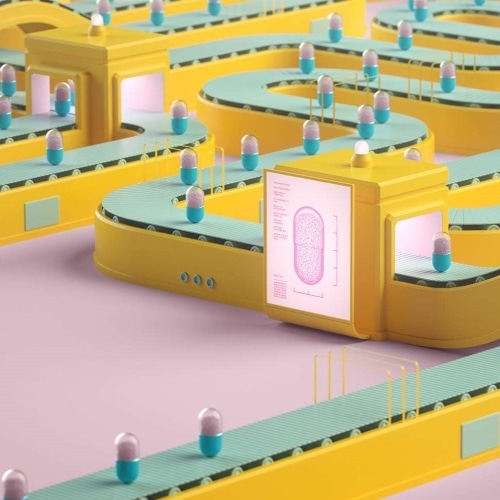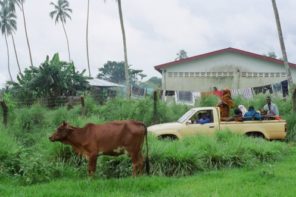How do globalised health regimes create and shape landscapes of medical regulation and patient safety? This essay asks about the many ways in which patients, consumers, health advocates, and providers relate to pharmaceuticals, and to the regimes of access, trust, and regulation that govern them. To ask this, I draw from ethnographic observation in the US, Mozambique, and India. Bringing ethnographic participation in access to medicine trainings together with ethnographic fieldwork on pharmaceutical production, export, and regulation, it aims to illustrate how multiple human, technological, and political actants – importers and inspectors, laboratory tests and documents, regulations and legal regimes – facilitate or foreclose what it means to have trust in pharmaceuticals. In so doing, affective and regulatory technologies of pharmaceutical trust work towards a variety of ends – drug safety, access to medicine, and political rights, as well as profit-making, patent-protection, and consumer-marketing.
Earlier this year, I attended an online training on self-managed medication abortion. In response to growing restrictions on abortion access in the United States (Andaya and Mishtal 2017), self-managed medication abortion and abortion-by-mail have become important alternatives to clinic-based services. [1] Run by a registered nurse and a group of women’s health advocates, the call aimed to provide interested members of the public – from the Zoom boxes, mostly but not only cisgendered women in their 20s, 30s, and 40s – with information, advice, and advocacy tips. During the call, we were taught how medication abortion works, about services available to connect people in need with providers, about the pharmaceuticals used (as well as, a brief discussion of “traditional” therapeutics used in abortion), about the legal landscape and risks associated with abortion-by-mail in the US, and about practical steps we could take to support access to reproductive care.
Partway through the session, a facilitator described how “abortion pills” – mifepristone and misoprostol – are made available online. For people in some US states, she said as she shared her screen to show us a color-coded map of the US, pills are prescribed and mailed by US-based providers. For those living in states with more restrictive abortion laws or telehealth regulations, services based outside the US can write prescriptions that are filled by online pharmacies. In her example, the facilitator described a service that connects patients in the US with India-based pharmacies. “But wherever the pills come from, they’re exactly the same thing and they work the same way,” she noted.
How are pharmaceutical safety, efficacy, and place of origin configured in this brief moment in a Zoom webinar? I start with this call because it attuned me to some of the ways in which patients, consumers, advocates, and providers can sit in complex relations to pharmaceuticals, and to the regimes of access, trust, and regulation that govern them (Davis 2019). Since 2018, I have been interested in how global health regimes create landscapes of regulation and patient safety. I have sought to learn more about this by tracing the movement of medicines between producers, exporters, importers and sites of consumption, focusing on routes within and parallel to global health institutions. My starting points for this project have been clinics, factories, pharmacies, and importers in Maputo, Mozambique, where I first conducted pharmaceutical ethnography, and the India-based producers and exporters who were involved in manufacturing and shipping some of the everyday medicines such as aspirin, antibiotics, anti-hypertensives, and vitamins that stock the shelves of Maputo pharmacies.
As pharmaceutical anthropology has shown, claims to pills “working the same way” no matter where they come from – or, conversely, assertions that national origin shapes pharmaceutical efficacy – have been central sites in which ideas, practices, and contestations of trust, trustworthiness, and suspicion have become visible. For instance, pharmacists might describe consumers (including me) as ranking medicines in terms of “trust,” and pharmaceutical quality was often colloquially mapped to notions of national identity and industrial origin, such that “European drugs,” “Indian generics,” and so on, could operate as a short-hand for relations of trust, mistrust, and suspicion located on a sliding scale of confidence. In these conversations, and in much anthropological literature, geography, efficacy, safety, and trust are entangled in the material form of the pharmaceutical itself.
The rich anthropological literature on pharmaceuticals (for a review see Hardon and Sanabria 2017) has shown how, because they bundle together material, epistemological, regulatory, and economic practices, medicines are good to think with. Much of the literature in which I situate this project has emphasised pharmaceutical circuits within the global South, showing how questions of access, therapeutic use, and safety are configured by the international patent regimes that shape pharmaceutical access and price, on the one hand, and global health institutions, on the other. For instance, in her ethnography of Nigerian pharmaceutical markets, anthropologist Kris Peterson (2014) has demonstrated how “fake” medicines flourished in the wake of structural adjustment programs that eviscerated local manufacturers and in the emergent space produced between expensive imported medicines and global health programs that purchased and distributed low-cost generic anti-retrovirals.
When I began fieldwork, however, I was not particularly focused on questions of real and fake, trustworthiness, or confidence. Instead, I was interested in how pharmaceuticals might make visible multiple forms of historical and transnational connection that make up and exceed global health. Yet, I soon found concern with fake – and conversely – trustworthy medications to be a frequent topic of conversation. Sometimes, it was patient concerns with medication efficacy that raised the question of real, fake, or trustworthy medicines. At other moments, the question of trust emerged not in relation to medicines but my own presumed skepticism – my identity, appearance, accent, and many questions prompting asides from importers or salespeople such as, “now, if you want to know about fraud, of course that happens but that is a different question.” And at still others, consumers might express their own doubts about medicines, or salespeople might recount moments of mistrust that they had experienced. While, in the words of the webinar, medicines are in many cases “exactly the same thing and work exactly the same” regardless of provenance, making medicines “exactly the same” in all places and contexts takes considerable cultural, chemical, and regulatory work (Hayden 2007).
This work of making medicines trustworthy involves chemists, regulators, manufacturers, marketers, salespeople, and researchers. While discussions of pharmaceutical safety and trust emerged in a variety of research settings – pharmacies and distribution warehouses in Maputo, a manufacturer’s office and an inspection site in India – they also appear in public media, policy reports, books, and exposes (Lancet 2012). They entail actors including industry groups, national regulatory agencies such as the US and Indian Food and Drug Administrations (FDA) and their equivalents elsewhere, international institutions [2], state agencies such as Ministries and Departments of Health, and corporate actors such as the drug certification programs run by major pharmaceutical manufacturers. Increasingly, this field has expanded to incorporate a growing number of actors, institutions and technologies involved in inspecting and certifying pharmaceutical quality, and with tracking and surveilling the movement of medicines around the world.
We can find one example of these new initiatives on a website commissioned by pharmaceutical manufacturer, Merck. Displaying a colorful infographic of the pharmaceutical distribution process, the website presents an illustrated, cartoon-like depiction of pharmaceutical supply chains. “When you pick up a prescription from your pharmacy,” reads the text, “it’s unlikely you’ll think to question the pills or medicine you’ve been given. The drug markets in most developed countries are highly regulated and a huge amount of care is taken to ensure that the treatments that reach our pharmacies are exactly what they say they are on the packet. However, in less regulated markets – and increasingly even in more highly regulated ones – a dangerous trade in counterfeit drugs is on the rise…” [3] It goes on to use falsified malaria drugs as a key example of what can go wrong. In so doing, the website contrasts its readers, consumers who are confident in “our” pharmacies, with those in “less regulated markets,” where fraudulent distributors generate falsified or unregistered products. In this narrative, too, trust in medicines adheres in nationally bounded units – “most developed countries” – understood to be sites of regulation and “a huge amount of care”. By contrasting this with “less regulated markets,” where consumers are less “confident” in their markets and where pharmaceuticals – and those who sell them – may be “dangerous” and fraudulent, the website operates within a field of already-configured spatialised and racialised assumptions about difference.
A similar narrative of regulatory variation was also present in ethnographic interviews I conducted with staff at an India-based, privately-owned pharmaceutical inspection firm. Unlike the top-down vision of the supply chain offered by the Merck website, this firm focused on testing and tracking medicines before they were shipped overseas. Supplementing factory inspections conducted by large regulators (such as the US and the Indian Food and Drug Administrations), as well as the import inspections conducted by customs officers, companies like this test pharmaceutical samples collected in manufacturing facilities and as pallets of medicines wait for export from warehouses and ports.
Entering the company offices, I expected to find laboratory facilities like the ones I had seen in the quality control departments of pharmaceutical factories. Instead, company staff explained that their key task consisted of generating and recording registration data. Walking me through the office, a staff member told me that the company’s first step had been simply to collect statutory information about the companies involved in producing and exporting drugs. They also collected and collated the documents needed for product registration – such as shipment packing lists, registration numbers, and import licenses issued. From all this data, she told me, it’s possible to see which exporters are “good” and which face “quality issues”. These points of information are then supplemented by chemical analyses of pharmaceutical samples. They also provide a means of checking up on possibly unscrupulous manufacturers, exporters, and distributors. Here, too, trust in pharmaceuticals was narrated together with trustworthy, and untrustworthy, actors and middlemen.
This company is one among many offering pharmaceutical “consumer empowerment” through “digital solutions” that enable “end-to-end transparency and visibility across the entire pharma supply chain,” and that use “mobile and web technologies in securing [medical] products against faking, counterfeiting, and diversion”. Offering alternatives to what one company referred to as “the 20th Century supply chain,” such services sell a technologically-mediated promise of safe medications and attendant affective benefits such as trustworthy goods and “empowered” consumers. As emergent regulatory practices, they show how consumer benefits (such as empowerment, safety, access, and trust) often understood to be made trustworthy in and through public institutions are also enabled by private companies using mobile technologies to supplement or supplant the authority of the state. They do so in part by mobilizing a pre-existing field of “difference” – including racialised national identities and development hierarchies – that serve to legitimate and necessitate these new technologies of surveillance (Hornberger 2018).
In an article on anthropology’s “Terms of Engagement,” Marilyn Strathern (2021) asks about the role of trust in shaping ethnographic practice and representation. For Strathern, trust evokes slippery questions of proximity, similarity and difference through which trust is cultivated or lost. Trust emerges out of and requires relations (whether trusting or skeptical), but it is also ambivalent. And crucially, it can also be something of a moving target. For instance, Strathern notes that when anthropology reevaluates “what is important, for and by whom, it must mistrust some terms of engagement in order to underline and urge trust in others” (2021: 285).
Strathern’s observation about the moving target of trust illuminates how distrust in some terms of engagement – insufficient regulation, untrustworthy pharmaceutical actors – can urge trust in others – blockchain and the promise that technological transparency will uphold, if tenuously, the distinction between “your” pharmacy and others. Her attention to proximity, distance, and similarity, too, characterise key terms through which medicines are made – and trusted – to “work in exactly the same way” (Hayden 2007).
For this reason, I want to circle back to the Zoom call. In the webinar, I saw how impending state control over reproduction was being met by new geographical and pharmaceutical connections. As abortion rights advocates use online overseas pharmacies to facilitate and support access to care they also evoke the trustworthiness of drugs in ways that entail but also exceed state regulation. In so doing, they illustrate how multiple human, technological, and political actants – importers and inspectors, laboratory tests and documents, regulations and legal regimes – facilitate or foreclose trust in a variety of ways and towards a variety of ends: drug safety, access to medicine, political rights, and consumer goods. The webinar helped me to imagine pharmaceutical regulation and trust as not only bundled into the dense material form of the pharmaceutical, whether “domestically produced” or “imported,” “European,” or “Indian” medicines. Rather, it highlighted how pharmaceutical trust emerges out of multiple actors and encounters – involving manufacturers, regulators, and pharmacists to be sure, but also the (inequitably) regulated body of the consumer or patient.
Different kinds of pharmaceutical access, safety, and trust, and different stakes to surveillance and control, emerge as medicines move through and across bodies, legal regimes, economic possibilities, and geographical spaces. Where advertising copy emphasises a risky global supply chain that imperils otherwise safe consumers, the Zoom call brings other forms of pharmaceutical regulation to the fore. It suggests how the disaggregation of state power and medical safety might appear not only as an artefact of neoliberalization, as trust moves from state institutions to privatised technologies of audit and surveillance, but also as a space of manoeuvre, as patients, activists, and consumers imagine trustworthy pharmaceutical access in new ways.
Endnotes:
[1] – Abortion-by-mail is one way of describing scenarios in which pregnant people in need of care can receive abortion pills, along with telephone-provided advice and support, from providers based in the United States or overseas
[2] – For example, the WHO Programme for International Drug Monitoring and the Uppsala Monitoring Centre.
References:
Andaya, Elise and Joanna Mishtal. 2017. “The Erosion of Abortion Rights in the United States: A Call for a Renewed Anthropological Engagement with the Politics of Abortion.” Medical Anthropology Quarterly 31(1): 40-59.
Davis, Dána-Ain. 2019. “Trump, Race, and Reproduction in the Afterlife of Slavery.” Cultural Anthropology 34(1): 26-33.
Editorial. 2012. “Counterfeit Drugs: A Growing Global Threat.” The Lancet 379 (February 12): 685.
Hayden, Cori. 2007. “A Generic Solution? Pharmaceuticals and the Politics of the Similar.” Current Anthropology 48 (4): 475–95.
Hardon, Anita and Emilia Sanabria. 2017. “Fluid Drugs: Revisiting the Anthropology of Pharmaceuticals.” Annual Review of Anthropology. 46:117-132.
Hornberger, Julia. 2018. “From Drug Safety to Drug Security: A Contemporary Shift in the Policing of Health.” Medical Anthropology Quarterly 32 (3): 365–83.
Peterson, Kristin. 2014. Speculative Markets: Drug Circuits and Derivative Life in Nigeria. Duke University Press.
Strathern, Marilyn. 2021. “Terms of Engagement.” Social Anthropology 29 (2): 283–97.
Featured image (cropped) provided by author.









